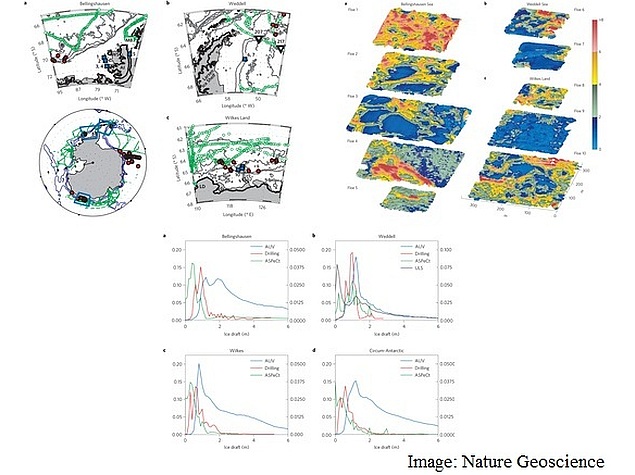- Home
- Science
- Science News
- Underwater Robot Measures Thickness of Antarctic Sea Ice
Underwater Robot Measures Thickness of Antarctic Sea Ice

Measuring the thickness of Antarctic sea ice, an important gauge of environmental conditions in this remote polar region in a time of global climate change, has proven to be a tricky task. But an underwater robot is providing a nice solution.
Satellite measurements can be skewed by surface snow, and some ice floes are simply too difficult to reach by ship, even icebreakers, to make direct measurements by drilling into them.
Scientists on Monday unveiled the first detailed, high-resolution 3D maps of Antarctic sea ice, based on measurements of the underside of ice floes by a remote-controlled submarine's upward-looking sonar.
The measurements, covering an area of about 5.4 million square feet (500,000 square metres), were made in 2010 and 2012 using a so-called Autonomous Underwater Vehicle dubbed SeaBED launched off a British and an Australian ship at three sites around the Antarctic Peninsula.
The scientists found sea ice thickness in some places up to about 55 feet (17 metres), with average thickness much less. The findings indicate the ice cover may be thicker in some areas than previously thought.
"Sea ice thickness and its variability in the Antarctic remains one of the great unknowns in the climate system," said sea ice expert Ted Maksym of Woods Hole Oceanographic Institution in Massachusetts.
Unlike in the Arctic region, where large declines in thickness have been measured in recent decades, scientists do not really have a good handle on the average Antarctic sea ice thickness or on any possible trends there, Maksym said.
"By demonstrating that detailed mapping of the thickness of the ice over large areas is possible deep in the ice pack, this represents and important step towards greater understanding of the processes that control the ice volume, particularly in areas that have been difficult to access," Maksym added.
The twin-hull underwater robot, about 6 feet (2 metres) long, operated at a depth of 65 to 100 feet (20 to 30 metres).
"While we have not measured all Antarctic sea ice thickness and cannot state if Antarctic sea ice is getting thicker, this study is a huge step towards the sort of expanded and more routine measurements we will need to do to truly answer these questions," said polar oceanographer Guy Williams of the Institute of Marine and Antarctic Studies in Australia.
The research was published in the journal Nature Geoscience.
© Thomson Reuters 2014
Catch the latest from the Consumer Electronics Show on Gadgets 360, at our CES 2026 hub.
Related Stories
- Samsung Galaxy Unpacked 2025
- ChatGPT
- Redmi Note 14 Pro+
- iPhone 16
- Apple Vision Pro
- Oneplus 12
- OnePlus Nord CE 3 Lite 5G
- iPhone 13
- Xiaomi 14 Pro
- Oppo Find N3
- Tecno Spark Go (2023)
- Realme V30
- Best Phones Under 25000
- Samsung Galaxy S24 Series
- Cryptocurrency
- iQoo 12
- Samsung Galaxy S24 Ultra
- Giottus
- Samsung Galaxy Z Flip 5
- Apple 'Scary Fast'
- Housefull 5
- GoPro Hero 12 Black Review
- Invincible Season 2
- JioGlass
- HD Ready TV
- Laptop Under 50000
- Smartwatch Under 10000
- Latest Mobile Phones
- Compare Phones
- OPPO Reno 15 Pro Max
- Honor Win RT
- Honor Win
- Xiaomi 17 Ultra Leica Edition
- Xiaomi 17 Ultra
- Huawei Nova 15
- Huawei Nova 15 Pro
- Huawei Nova 15 Ultra
- Asus ProArt P16
- MacBook Pro 14-inch (M5, 2025)
- OPPO Pad Air 5
- Huawei MatePad 11.5 (2026)
- Xiaomi Watch 5
- Huawei Watch 10th Anniversary Edition
- Acerpure Nitro Z Series 100-inch QLED TV
- Samsung 43 Inch LED Ultra HD (4K) Smart TV (UA43UE81AFULXL)
- Asus ROG Ally
- Nintendo Switch Lite
- Haier 1.6 Ton 5 Star Inverter Split AC (HSU19G-MZAID5BN-INV)
- Haier 1.6 Ton 5 Star Inverter Split AC (HSU19G-MZAIM5BN-INV)

















